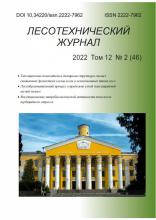Krasnoyarsk, Krasnodar, Russian Federation
Krasnoyarsk, Krasnoyarsk, Russian Federation
Krasnoyarsk, Krasnoyarsk, Russian Federation
Krasnoyarsk, Krasnoyarsk, Russian Federation
Krasnoyarsk, Krasnoyarsk, Russian Federation
The study of the structure was based on a series of distribution by the steps of the thickness. Measurements were carried out in forest shelter belts of the southern part of Central Siberia. Plots were laid on the territory of the Republic of Khakassia (Ust- Abakan, Bay, Shirinsky, Shushensky districts), Krasnoyarsk territory (Minusinsk district) and the Republic of Tuva (Kyzylskiy district). Approximation of distribution rows by diameter has been implemented by two functions: normal distribution and Weibull distribution. With respect to protective forest belts for most forest stands, structure by diameter is more adequately approximated by normal distribution, indicating the symmetry rows. But at this, function of Weibull is characterized by high correlation of its ratios with parameters of plantations, in particular with average diameter and normalized variability. Based on the study of the structure of the plantings in diameter, the optimal agro-technical indicators for the cultivation of plantations presented a variety of wood species, were revealed. It is recommended to divide rows into two groups, before forecasting the series. The first category reflects the influence of the internal (growth) processes: growth, mortality, movement of trees on the steps. These rows can be predicted taking into account the average diameter of tree stand and theoretical density (square of nutrition of individual tree). The second group of rows was formed under the influence of external factors (supplement, renewal, felling, and forest fires).These rows are forecasted using the average diameter and standard deviation of trees. For the prediction of the structure of the stands of Siberian larch, silver birch, Siberian elm and black poplar, model based on the Weibull function, were obtained.
forest belts, structure on diameter, agronomic indicators, forecasting.
1. Ivanov A.N. [et al.]. Agrolesomelioracija [Agrolesomelioration]. Volgograd, 2006, 746 p. (In Russian).
2. Lobanov A.I., Savin E.N. Sostojanie polezashhitnyh nasazhdenij i metodologija sozdanija ih novogo pokolenija v Respublike Hakassija i juzhnyh rajonov Krasnojarskogo kraja [Sostoyaniye of field-protecting plantings and methodology of creation of their new generation in the Republic of Khakassia and the southern areas of Krasnoyarsk edge] Jekologogeograficheskie aspekty lesoobrazovatel'nogo processa: mat. Vserossijskoj konferencii [Ekologo-geografichesky aspects of lesoobrazovatelny process: mat. All-Russian Conference]. Krasnoyarsk, 2009, pp. 104-107. (In Russian).
3. Verkhunov P.M. Zakonomernosti stroenija raznovozrastnyh sosnjakov [Regularities of a structure of unevenage pine forests] Novosibirsk, 1976, 253 p. (In Russian).
4. Lebkov V.F. Tipy stroenija drevostoev [Types of a structure of forest stands] Lesovedenie [Lesovedeniye]. 1989, no. 4, pp. 12-21. (In Russian).
5. Makarenko A.A. O prichinah dinamiki stroenija drevostoev [About the reasons of dynamics of a structure of forest stands] Lesovedenie [Lesovedeniye]. 1972, no. 6, pp. 13-20. (In Russian).
6. Kaplunov V.Ya. Analiz dinamiki odnovozrastnyh sosnjakov i razrabotka rezhimov lesovyrashhivanija avtoref. kand. s-h. nauk [Analysis of the dynamics of even-aged pine forest growing and working condition: abstract Phd in Agricultural]. Krasnoyarsk, 1987, 19 p. (In Russian).
7. Ganina N.V. Raspredelenie derev'ev po diametru s pomoshh'ju funkcii Vejbulla [Distribution of trees on diameter by means of Veybull] Lesovedenie [Lesovedeniye]. 1984, no. 2, pp. 65-70. (In Russian).
8. Slopes S.N. Ob ocenke prigodnosti raspredelenija Vejbulla dlja opisanija stroenija drevostoev [About assessment of suitability of distribution of Veybull for the description of a structure of forest stands] Voprosy vyrashhivanija i racional'nogo lesopol'zovanija: sb. St [Questions of cultivation and rational forest exploitation: collection. thearticles]. Moscow, 1982, Issue 139, pp. 172-174. (In Russian).
9. Zeide B. Exponential diameter distribution: interpretation of coefficients. Forest Science, 1984, Vol. 30, no. 4, pp. 907-912.
10. Enquist B.J., Niklas K.J. Invariant scaling relations across tree-dominated communities. Nature, 2001, Vol. 410, no.5, pp. 655-660.
11. Niklas K. J., Midgley J.J., Rand R.H. Tree size frequency distributions, plant density, age and community disturbance. Ecology letters, 2003, no.6, pp. 405-411. DOI: https://doi.org/10.1046/j.1461-0248.2003.00440.x; EDN: https://elibrary.ru/BGRGHR
12. Shimano K.A. Power functions for forest structure and regeneration pattern of pioneer and climax species in patch mosaic forests. Plant Ecology, 2000, no. 146, pp. 207-220.












